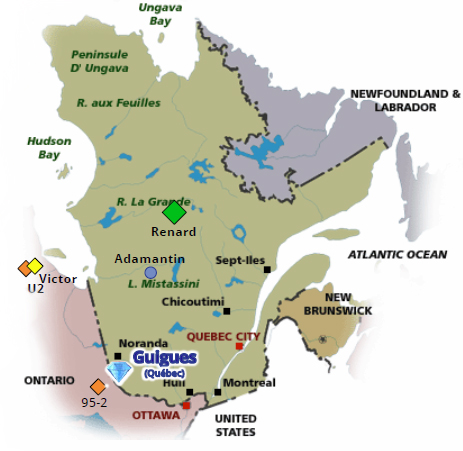
Tres-Or Resources Ltd. is exploring its 100% owned Guigues Kimberlite pipe in southwestern Québec for diamonds. Tres-Or’s diamond testing programs began in December 2019 with completion of 5 HQ (62 mm diameter) core drill holes totaling 1,432m. Each of the 5 completed holes intersected kimberlite and core samples yielded significant counts of microdiamonds. Two of the five holes were vertical and ended in kimberlite at 300 m, demonstrating that the pipe extends to great depth. The Guigues Kimberlite has substantial size (4.6 to 7 hectares), excellent local infrastructure, and importantly, Type II microdiamond content as well as highly encouraging diamond indicator mineral chemistry.
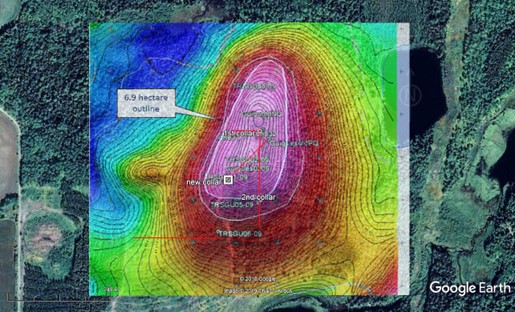
Highlights from Tres-Or’s drill testing programs:
Guigues 2021 Drill Program
Tres-Or completed the first macrodiamond drill program at the Guigues Kimberlite Pipe in southwestern Québec. The planned 5 holes have been completed to 300 m each, providing more than 10 tonnes of kimberlite sample for mini-bulk macrodiamond testing. Four of the holes ended in kimberlite at 300 m, and the fifth hole entered metasediment county rock at 262.10 m. The drill was operated 24 hours a day by Forage DCB Drilling Inc. of Rouyn-Noranda, Québec and finished the entire 1,500 m of HQ (64 mm diameter) core program in one week.
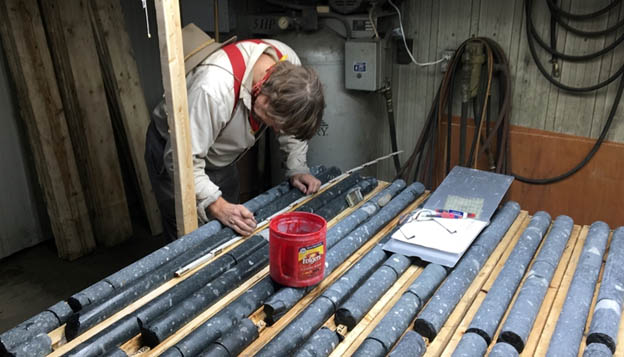
Schematic Cross Section presenting the November 2021 drilling program for macrodiamond testing of the Guigues Kimberlite Pipe
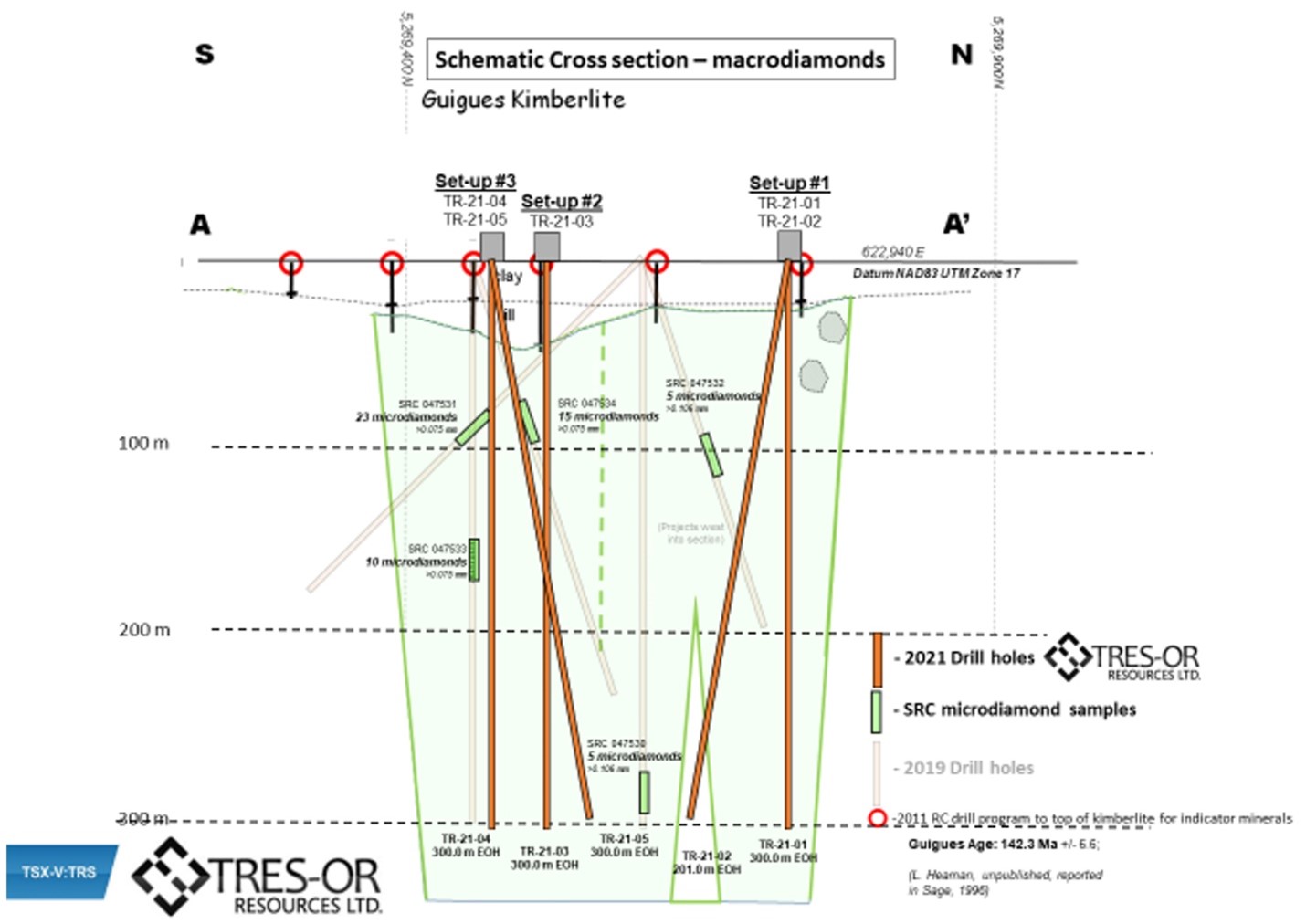
2021 Drill holes completed:
The kimberlite core will provide the sample for the recovery of macrodiamonds by testing at an independent Canadian laboratory. Following this drill program, Tres-Or anticipates recovering all diamonds greater 0.425 mm in diameter, from a mini-bulk sample total weight in excess of 10 tonnes. Approximately 8 tonnes of kimberlite core has been collected during this drill program.
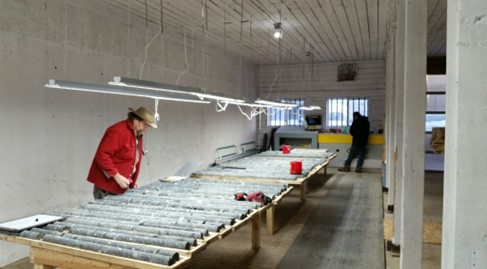
Logging of the core was completed on the Timiskaming First Nations Reserve in Notre Dame du Nord, and supports multiple intrusive phases of kimberlite, each with the potential or carrying a different concentration of macrodiamonds.
Guigues Microdiamond Test Results from SRC Labs
Tres-Or recovered 58 microdiamonds from 5 samples of the Guigues Kimberlite pipe in southwestern Québec weighing 511.6 kgs, by the Saskatchewan Research Council Geoanalytical Laboratories Diamond Services (“SRC”) as outlined below. The largest two microdiamonds remained on a 0.425 mm square mesh screen (Table 1). All but 3 of the recovered microdiamonds are described by SRC as “White/Colourless, Transparent” with no or minor inclusions. Only one microdiamond is described as having “noticeable inclusions”.
New microdiamond results from the Guigues Kimberlite pipe.
| Total Weight |
Numbers of Diamonds According to Sieve Size Fraction (mm) | # of Stones |
||||||
|---|---|---|---|---|---|---|---|---|
| +0.075 | +0.106 | +0.150 | +0.212 | +0.300 | +0.425 | +0.600 | ||
| Kg | -0.106 | -0.150 | -0.212 | -0.300 | -0.425 | -0.600 | -0.85 | |
| 511.6 | 19 | 18 | 10 | 3 | 6 | 2 | 0 | 58 |
The 511.6 kgs of material processed for microdiamonds comprise 5 samples from half-split drill core (HQ size) testing different parts of the pipe. Recovered microdiamonds are well distributed throughout the pipe. Out of 65 sample bags processed, 30 returned at least one microdiamond. The 13 bags comprising sample 047531 returned the most total microdiamonds at 22, suggesting the possibility of a higher grade phase in the southern part of the pipe, but more data is required to gain confidence in this possibility. Tres-Or will be looking to identify potentially higher grade kimberlite phases as additional sample data becomes available.
Each sample was bagged successively by Tres-Or personnel, in approximately 8 kg sub-samples. The total sample interval extends approximately 26 m in length. After bagging and labelling, the samples were delivered to SRC in Saskatoon, Saskatchewan. The unsampled half split of core is stored securely for future reference. The ~8 kg bags were processed by SRC as separate batches and microdiamond recoveries were reported for each of the 8 kg bags. SRC reports microdiamond counts by square mesh screen sizes, increasing successively from the smallest size (in this case 0.075 mm) upwards by a factor of the square root of 2, as specified in CIM reporting standards required under Canadian National Instrument 43-101 reporting standards. SRC also describes and reports dimensions as well as weights for each individual microdiamond.
The abundance of microdiamonds compares well with the published results for the Victor Kimberlite (De Beers’ Victor Diamond Mine located 670 km to the northwest of Guigues in the James Bay Lowlands) which Tres-Or considers significant because of the similarities between Victor and Guigues mantle indicator mineral samples (see Tres-Or news releases of November 9, 2020, December 14, 2020 and January 5, 2021).
Victor microdiamond data in the public domain is limited, with the most detail being provided in a De Beers’ assessment report on Victor and nearby pipes (Winzar, 2001). By adding Guigues total data to that provided in Winzar’s report (2001), Guigues’ microdiamond recovery at 1.1 per 10 kgs compares to Victor at 1.3 per 10 kgs, although the Victor sample was twice as big at 1,080.7 kgs. Note that the reported De Beers data was from work completed before approximately 1996 and did not follow the later CIM reporting standards of specified square mesh screen sizes increasing by a factor of the square root of 2. Note also that although Victor’s published indicator mineral and microdiamond data are both closely similar to Guigues, that work was not done or confirmed by a Qualified Person (QP) working for Tres-Or, nor does it necessarily imply the Guigues pipe has a similar macrodiamond population to the Victor Diamond Mine (although Tres-Or believes Guigues merits further micro- and macrodiamond sampling).
Tres-Or 2019-2020 Drill and Microdiamond testing program at Guigues
The microdiamond samples were collected from (HQ) core recovered form Tres-Or’s 5 hole, 1432 m drill program in December, 2019. Tres-Or completed the 5 HQ core drill holes from two set-ups totaling 1,432 m (Fig. 1). Each of the 5 completed holes intersected kimberlite, and the two vertical holes ended in kimberlite at 300 m. The five SRC caustic fusion samples are well distributed through the pipe (Fig.2).
Figure 1: Surface map of drill hole traces.
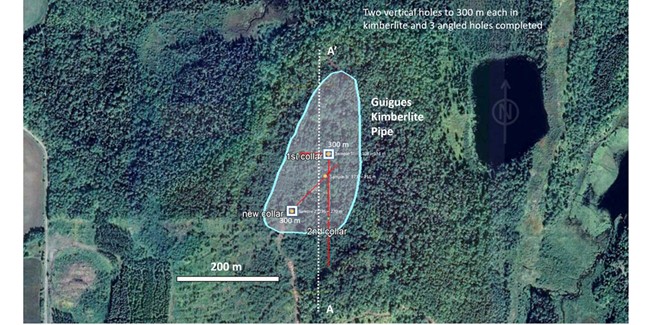
Figure 2: Schematic drill section showing relative positions and results of SRC microdiamond samples (green intervals). Note drill hole TR-19-03 projects west into the section.
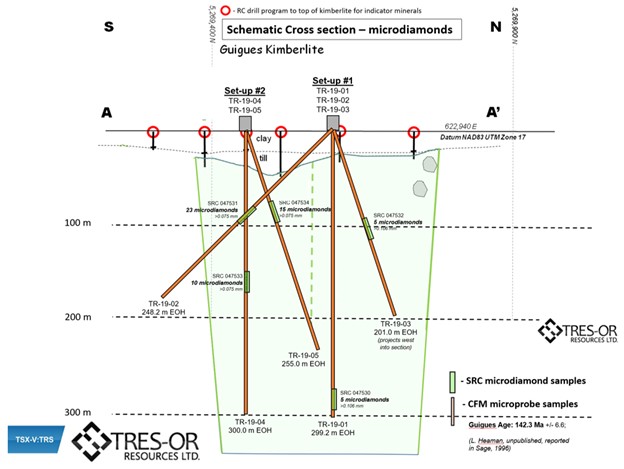
Type II diamond dominates at the Guigues Kimberlite Pipe
Guigues Kimberlite microdiamonds are dominantly Type II, meaning that the lack nitrogen. Type II comprise 16 out of a total of 21 microdiamonds (76%) large enough (i.e. >0.150 mm) for SRC to measure using their laboratory standard method of nitrogen impurity measurement by Fourier Transform Infrared (FTIR) spectroscopy. The Type II diamonds are well distributed amongst the SRC microdiamond samples supporting widespread occurrence within the pipe.
Photomicrographs were produced by SRC from all 21 microdiamonds greater than 0.150 mm recovered from Guigues (refer to Tres-Or news releases dated December 8, 2020, January 5, 2021, April 6, 2021 and May 5, 2021).
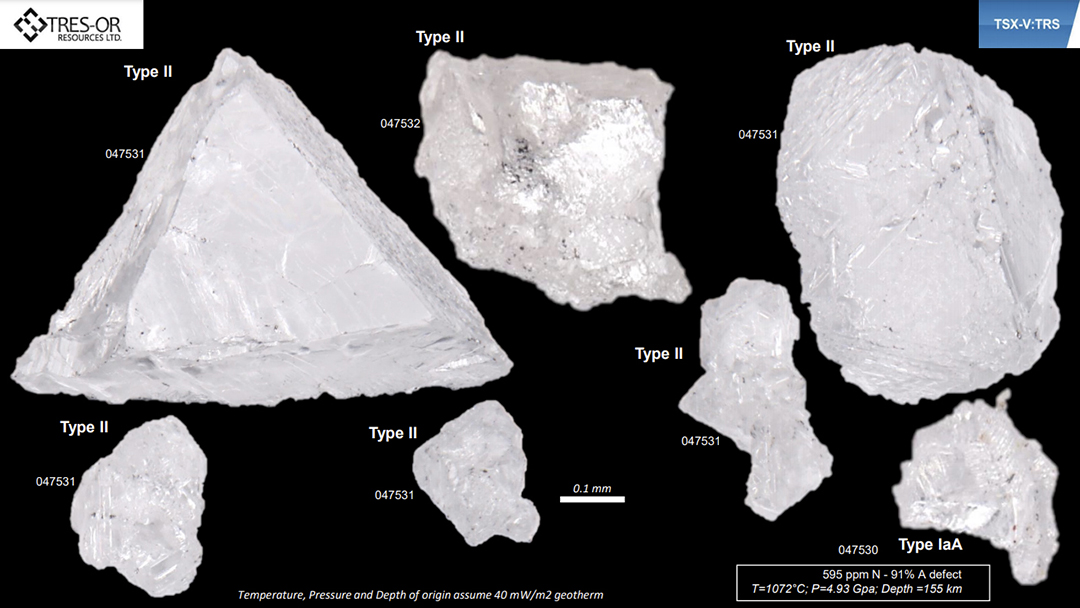
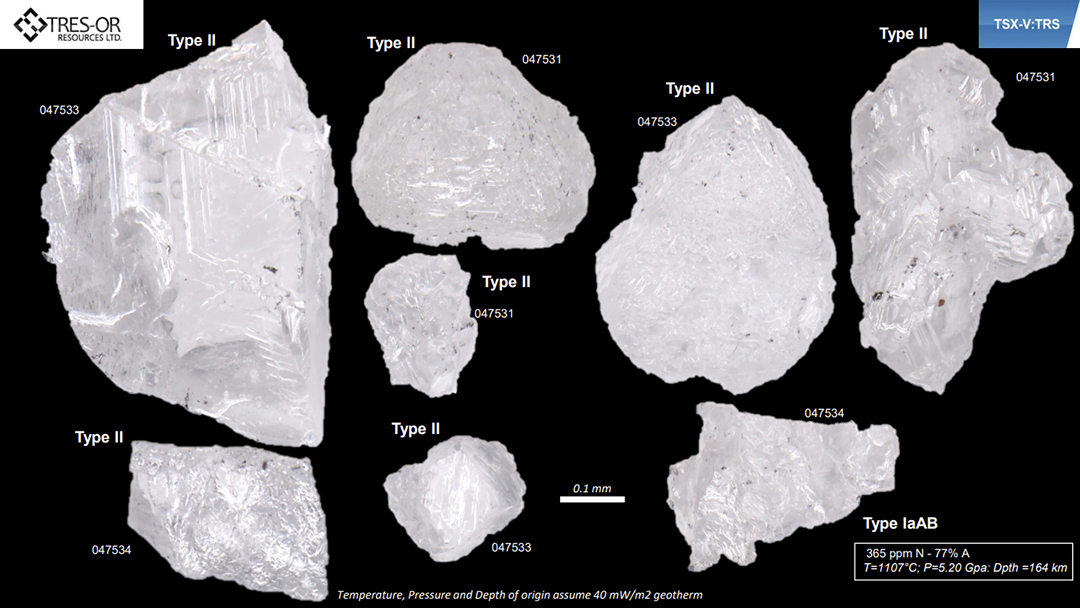
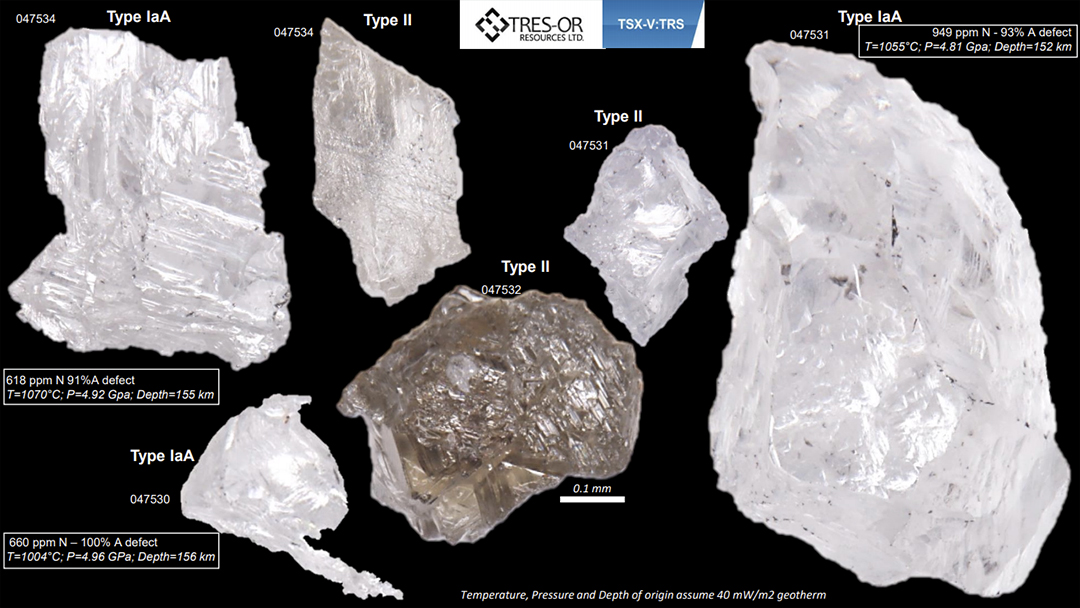
Type II diamonds (sometimes referred to as Type IIa) lack nitrogen and famously include some of the largest, highest quality diamonds recovered at mines around the world (e.g. including the historic 1,758 Sewelô, the 1,109 carat Lesedi La Rona and the 813 carat Constellation diamonds from the Karowe Mine in Botswana, as well as the famous +3,000 carat Cullinan diamond from the Premier Mine in South Africa, and a flawless D color, 271 carat stone from De Beers’ Victor Diamond Mine in northern Ontario), although they are rare and only make up an estimated 1 to 2% of diamond production world-wide (see Table 1 from Tres-Or December 8, 2020 news release).
The Guigues microdiamonds are also described dominantly (90%) by SRC evaluators as white/colourless and transparent.
[Note: Type II diamonds are defined as lacking nitrogen; they are equivalent to Type IIa diamonds which are additionally defined as lacking trace boron impurities which results in a blue color, such as the famous Hope diamond. Nitrogen measurements were conducted by the Saskatchewan Research Council Geoanalytical Laboratories Diamond Services (SRC) on all Guigues +0.150 mm microdiamonds, using the industry-standard technique of micro-Fourier Transform Infrared Spectroscopy (FTIR). SRC does not report boron, thus all analyses lacking nitrogen are reported as Type II.]
Note that although the recovery of Type II microdiamonds from the Guigues Kimberlite is suggestive of the occurrence of larger stones, this does not mean that the Guigues Kimberlite will necessarily host large Type II diamonds.
Guigues indicator mineral chemistry highly prospective and comparable to De Beers’ Victor Diamond mine in Ontario
The highly encouraging indicator mineral chemistry at Guigues is closely similar to De Beers’ Victor Diamond Mine, and differs from the standard model for diamond exploration. The Guigues Kimberlite diamond potential, like that of the Victor Diamond Mine, is based on high-priority source of diamonds from mantle eclogite and lherzolite rocks, instead of the standard harzburgite (G10) sources. The potential diamond source for Guigues is marked by recovery of eclogite and lherzolite garnets that have distinctive compositions just like diamond inclusions recently described from Victor by Stachel et al. (2018). The dominance of lherzolite garnets as inclusions in Victor diamonds (along with a lesser proportion of eclogite garnet inclusions) is unique among diamond mines around the world, and as Thomas Stachel, the University of Alberta researcher who made this discovery points out, may lead to a new model for diamond targets. The Guigues Kimberlite yields numerous lherzolite and eclogite garnets of comparable diamond inclusion composition, as recently confirmed by application of CF Mineral Research Laboratory’s updated classification system by owner and originator Dr. Charles Fipke. Guigues is thus a priority target for this new diamond potential model.
Tres-Or is encouraged by the diamond indicator mineral chemistry reported from samples of Guigues drill core sent to C.F. Mineral Research Limited, an ISO 9001:2015 certified/ISO 17025:2005 compliant laboratory in Kelowna, B.C during the year.
C.F. Minerals, hand-picked over 8,000 indicator minerals and then selected 701 for new microprobe analyses. The analyzed indicator minerals include eclogite and pyropes garnets, chromite, chrome diopside, picroilmenite, and olivine recovered from different parts of the pipe (Table 2). The new microprobe results support Tres-Or’s previous interpretation of a mantle indicator mineral signature comparable to the Victor kimberlite, especially in regards to having numerous eclogitic and lherzolitic garnets with compositions similar to diamond inclusions at Victor (Stachel, et al., 2020). C.F. Minerals also examined sample residues for microdiamonds, recovering 5 natural stones, all less than 106 microns in size.
In total, the 3 samples weighed 393.34 kgs and after arrival in Kelowna and were disaggregated by attrition milling, with the +106 micron material concentrated by density and magnetic properties.
Table 2: Counts of diamond inclusion (DI) composition indicator minerals
| CFM CLASSIFICATION SUMMARY TABLE | ||||
|---|---|---|---|---|
| GUIGUES | DI | PROB DI | POSS DI | |
| * | EG | 4 | 12 | 15 |
| PY | 3 | 8 | ||
| OL | 12 | 12 | ||
| CHR | 1 | |||
| CD | 1 | 9 | ||
The highly encouraging indicator mineral chemistry at Guigues is closely similar to De Beers’ Victor Diamond Mine, and differs from the standard model for diamond exploration. The Guigues Kimberlite diamond potential, like that of the Victor Diamond Mine, is based on high-priority source of diamonds from mantle eclogite and lherzolite rocks, instead of the standard harzburgite (G10) sources. The potential diamond source for Guigues is marked by recovery of eclogite and lherzolite garnets that have distinctive compositions just like diamond inclusions recently described from Victor by Stachel et al. (2018). The Guigues Kimberlite yields numerous lherzolite and eclogite garnets of comparable diamond inclusion composition, as recently confirmed by application of CF Mineral Research Laboratory’s updated classification system by owner and originator Dr. Charles Fipke.
The overlay of the fields for Victor’s lherzolitic and eclogitic diamond inclusions with those from the Guigues Kimberlite shows the strong similarities between garnet populations (Figure 3).
Figure 3: All garnet analyses from the Guigues Kimberlite. Fields from Victor diamond inclusions.
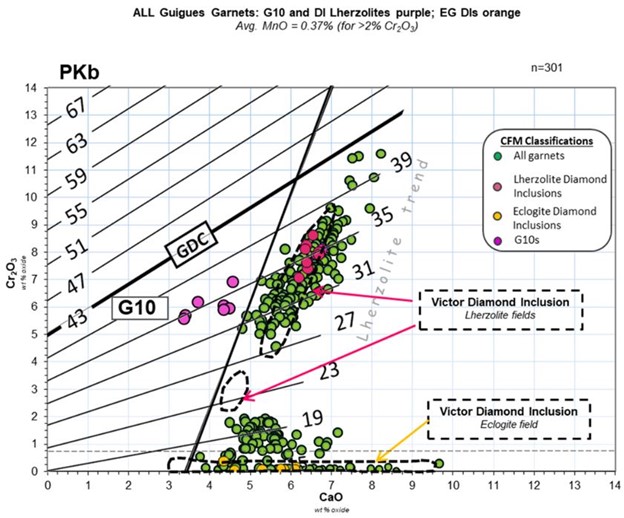
Eclogite garnet inclusions from Victor (analyses below 0.75% Cr2O3 above) show a strong population of low titanium and increasing sodium, similar to eclogite garnet inclusions from around the world, including Victor (Figure 4).
Figure 4: Low chromium garnets from Guigues, including those that plot in the eclogite diamond inclusion field.
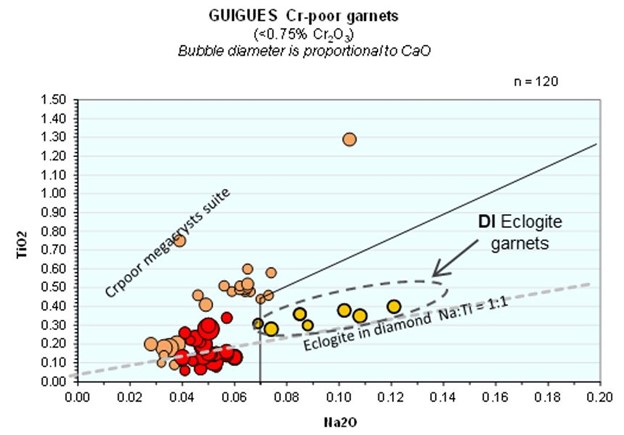
Microdiamond counts were reported in Tres-Or’s news releases dated November 9, 2020, December 14, 2020 and January 5, 2021 using modern microdiamond methods at the Saskatchewan Research Council Geoanalytical Laboratories Diamond Services (SRC). In total, 6 of the sample bags yielded between 1 and 4 microdiamonds each (27 bags (8 kg each) analyzed), consistent with reasonably widespread distribution of diamonds throughout the tested kimberlite intervals. In other words the microdiamonds were not derived from just one or two places, as might happen with a single stone crushed during sampling, or a group of stones from a single diamond-bearing mantle xenolith.
Cautionary Statement:
Note that although the indicator mineral chemistry is closely similar to the Victor Diamond Mine, and the microdiamond results reported point towards potential to carry larger stones (refer to Type II microdiamonds recovered from Guigues as reported in Tres-Or’s news release dated December 8, 2020), this does not necessarily mean the Guigues Kimberlite will host diamonds of economic size. Tres-Or’s ongoing microdiamond tests are expected to better define the potential to host economic diamonds.
Guigues story
The Guigues Kimberlite was discovered by De Beers in 1983, and was the first kimberlite pipe discovered in eastern Canada. De Beers drilled two holes (working at the time under the name Monopros), and filed the work with the Québec government sufficient to hold the claims only until 1989, when the claims expired (ironically, the low cost of operating around Guigues may have contributed to De Beers losing the claims too soon!). Guigues lacked G10 garnet chemistry, and was not further pursued by De Beers. Notably, in 1987 De Beers discovered the Victor Kimberlite, along with others in the Attawapiskat region of Ontario. Like Guigues, Victor lacks G10 garnets and was not prioritized by De Beers, which moved their Canadian focus to the NWT after Fipke’s famous discovery of diamonds there near Lac de Gras in 1992. However, De Beers had completed enough work to keep the Victor claims until the late 1990s, when they went back and refocused on Victor. This refocus better recognized the importance of eclogite as a potential mantle source for diamonds, and utilized more reliable microdiamond testing methods to convince De Beers they had a significant diamond mine at Victor. By this time, however, De Beers had long lost the Guigues claims so refocusing at Guigues was not possible. In fact, Tres-Or Resources had taken control of the claims covering Guigues, and continues to hold them now.
Tres-Or first reached the top of the kimberlite to recover indicator minerals using short RC drill holes in 2011. Included among the recovered indicator minerals were numerous distinctive and high-priority eclogite garnets, comparable to inclusions in diamonds from around the world. In addition, Tres-Or identified a single chromite and several chrome diopsides with compositions pointing to the kimberlite being derived from the diamond stability field. The eclogite garnets with diamond inclusion compositions were especially encouraging because eclogite with abundant diamonds is known from mines around the world.
Because of the distinctive eclogite garnets from Guigues with diamond inclusion compositions, Tres-Or made plans to complete five drill holes for core, testing all parts of the Guigues kimberlite for microdiamonds.
Encouragingly, recent published research with Victor diamonds has further enhanced the potential for Guigues to host diamonds. Specifically, after the research team at U of A led by Thomas Stachel demonstrated that both eclogite and lherzolite garnets occur as inclusions in Victor diamonds (and no G10s!), Dr. Charles Fipke reclassified Tres-Or’s Guigues indicator mineral chemistry using his updated classification system, identifying numerous lherzolite garnets with diamond inclusion compositions just like Victor’s diamond inclusions, in addition to the already prioritized diamond inclusion eclogite garnets. The abundance of eclogite and lherzolite indicators associated with diamond makes Guigues a high-priority unconventional diamond target, just like Victor.
REFERENCES:
